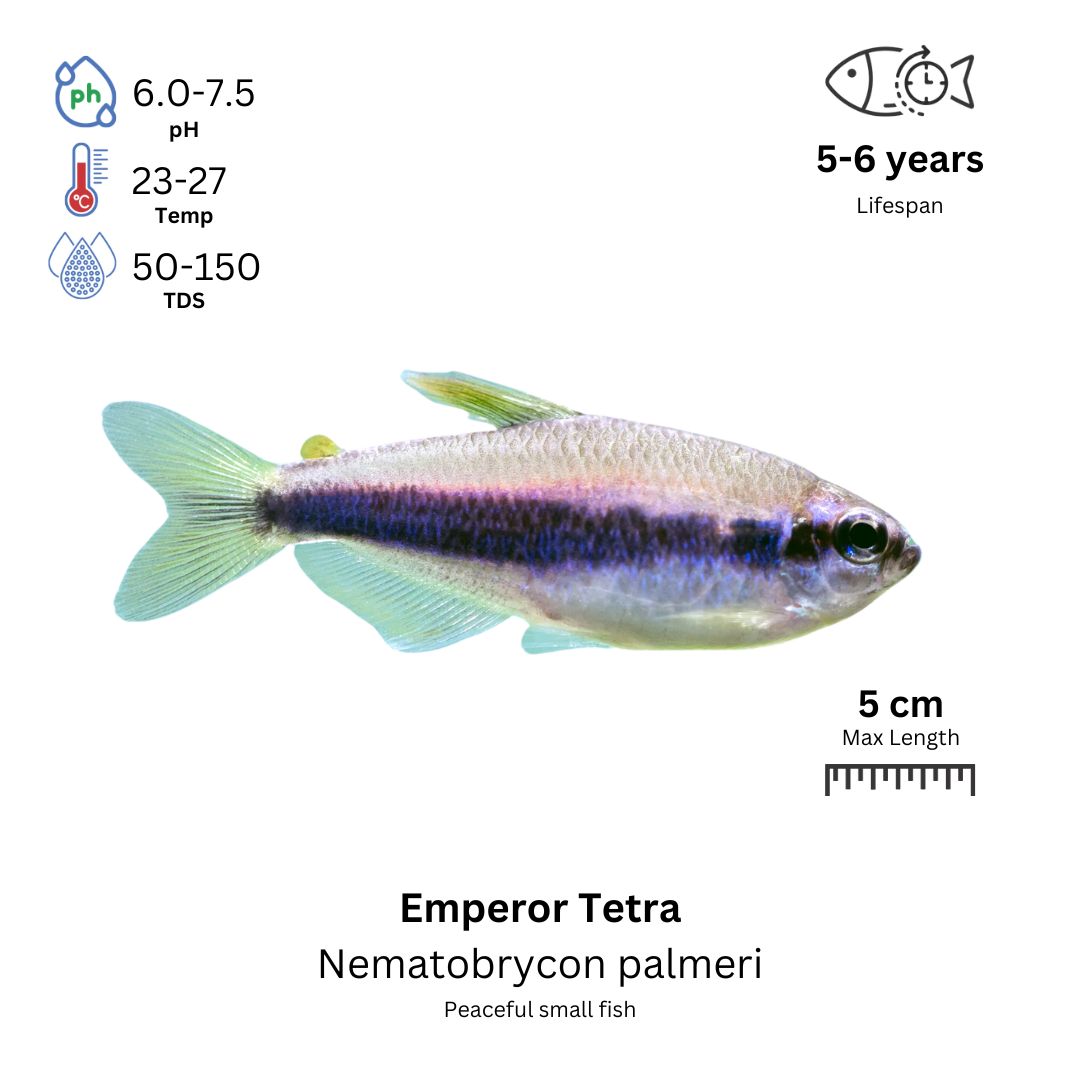Emperor Tetra: Fish Species Profile
Characteristics
- Scientific Name: Nematobrycon palmeri
- Family: Characidae
- Origin: Colombia, South America
- Social Behavior: Peaceful, schooling fish
- Tank Level: Middle regions
- Minimum Tank Size: 20 gallons
- Diet: Omnivore
- Breeding Method: Egg layer
- Care Level: Beginner-friendly
- Preferred pH Range: 5.0 to 7.8
- Water Hardness: 3 to 8 dKH
- Temperature Range: 73 to 81°F (23 to 27°C)
Origin and Distribution
Emperor tetras are native to the slow-moving rivers and streams of Colombia, particularly within the Atrato and San Juan river basins. These environments are characterized by warm, moderately hard waters with dense vegetation, providing ample hiding spots and subdued lighting conditions.
Colors and Markings
Emperor tetras exhibit a striking appearance with a slender, elongated body. A prominent black stripe runs horizontally from the eye to the tail, bordered by iridescent blue or purple hues. Their fins are often tinged with shades of blue, black, and white, adding to their elegant look. Males typically display more vibrant colors and have extended dorsal and caudal fins compared to females.
Tankmates
Due to their peaceful nature, emperor tetras are well-suited for community aquariums. Compatible tankmates include:
- Other small, non-aggressive tetras
- Rasboras
- Dwarf gouramis
- Corydoras catfish
- Small, peaceful barbs
It’s advisable to avoid housing them with larger, aggressive species that may exhibit fin-nipping behavior or view them as prey.
Care
Emperor tetras are relatively hardy and adaptable, making them suitable for both novice and experienced aquarists. To ensure their well-being:
- Tank Setup: Provide a well-planted aquarium with ample hiding spots using live plants, driftwood, and rocks. A dark-colored substrate can help accentuate their colors.
- Lighting: Subdued lighting conditions are preferred, as bright lights may cause stress.
- Water Parameters: Maintain stable water conditions within the preferred ranges. Regular water changes and efficient filtration are essential to keep ammonia and nitrate levels low.
- Group Size: Keep them in groups of at least six to promote natural schooling behavior and reduce stress.
Diet and Feeding
As omnivores, emperor tetras thrive on a varied diet. Offer high-quality flake or pellet foods as a staple, supplemented with live or frozen options such as brine shrimp, daphnia, and bloodworms. Incorporating vegetable matter, like blanched spinach or spirulina-based foods, can also benefit their health. Feed them small amounts multiple times a day, ensuring they consume all the food within a few minutes to prevent overfeeding and maintain water quality.
Gender Differences
Males are generally more colorful and possess longer, more pointed dorsal and caudal fins. They also have a more pronounced extension of the central caudal fin ray, giving the tail a trident-like appearance. Females tend to be slightly larger with a rounder abdomen, especially when carrying eggs, and have shorter, more rounded fins.
Breeding
Breeding emperor tetras in captivity is achievable with proper conditions:
- Breeding Tank: Set up a separate tank with soft, slightly acidic water (pH around 6.0 to 6.5) and a temperature of about 77°F (25°C). Dim lighting and fine-leaved plants or spawning mops are recommended.
- Spawning: Condition the breeding pair with high-quality live or frozen foods. The female will scatter eggs among the plants, and the male will fertilize them.
- Post-Spawning: Remove the adults after spawning to prevent them from eating the eggs. Eggs typically hatch within 24 to 36 hours.
- Fry Care: Feed the fry infusoria or commercially available liquid fry food until they are large enough to accept finely crushed flake food or baby brine shrimp.
Further Research
For more detailed information on emperor tetra care, breeding techniques, and tank setups, consider exploring specialized aquarium literature or consulting with experienced aquarists.
FAQ
How many emperor tetras should I keep together? It’s recommended to keep them in groups of at least six to promote natural schooling behavior and reduce stress.
Are emperor tetras suitable for beginners? Yes, their hardy nature and peaceful temperament make them excellent choices for novice aquarists.
Can emperor tetras live with betta fish? While emperor tetras are peaceful, bettas can be aggressive. It’s generally not recommended to house them together, as bettas may attack tetras, especially males with colorful, flowing fins.


Reviews
There are no reviews yet.